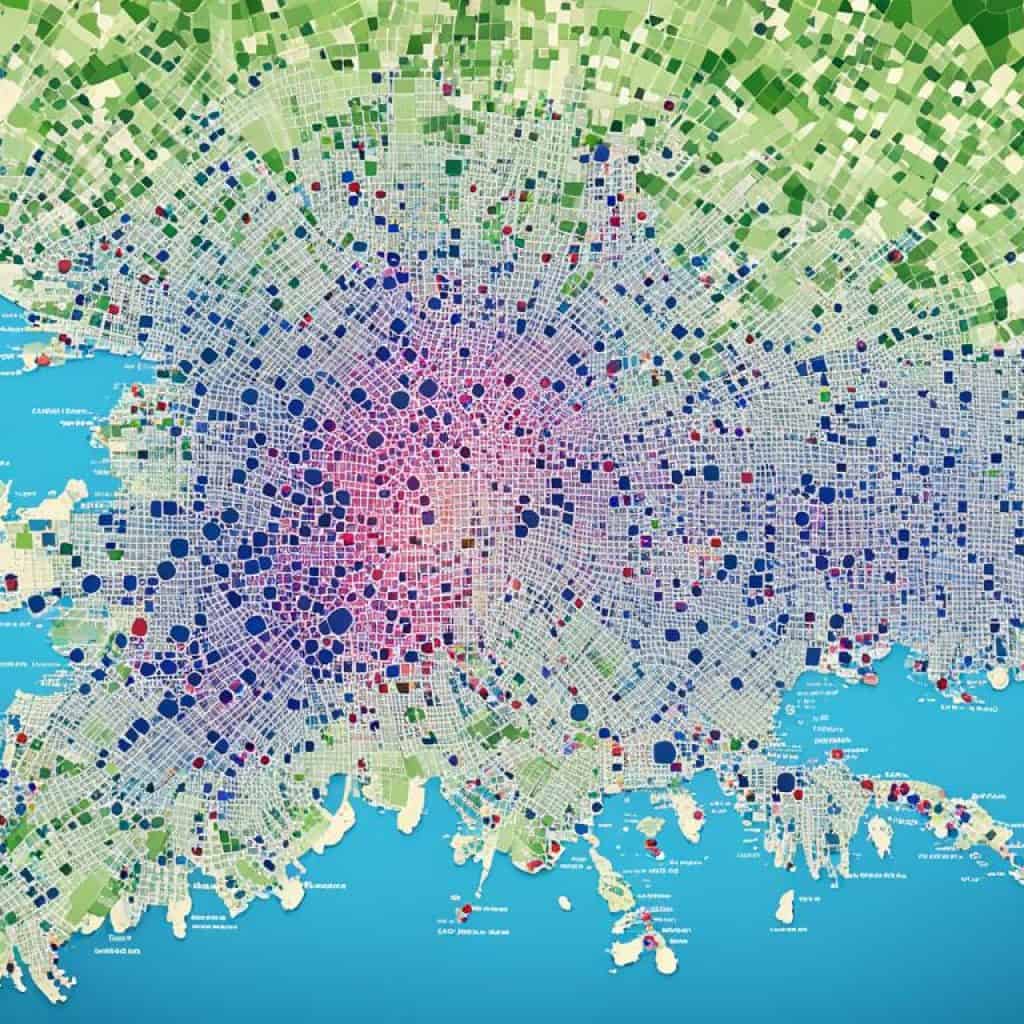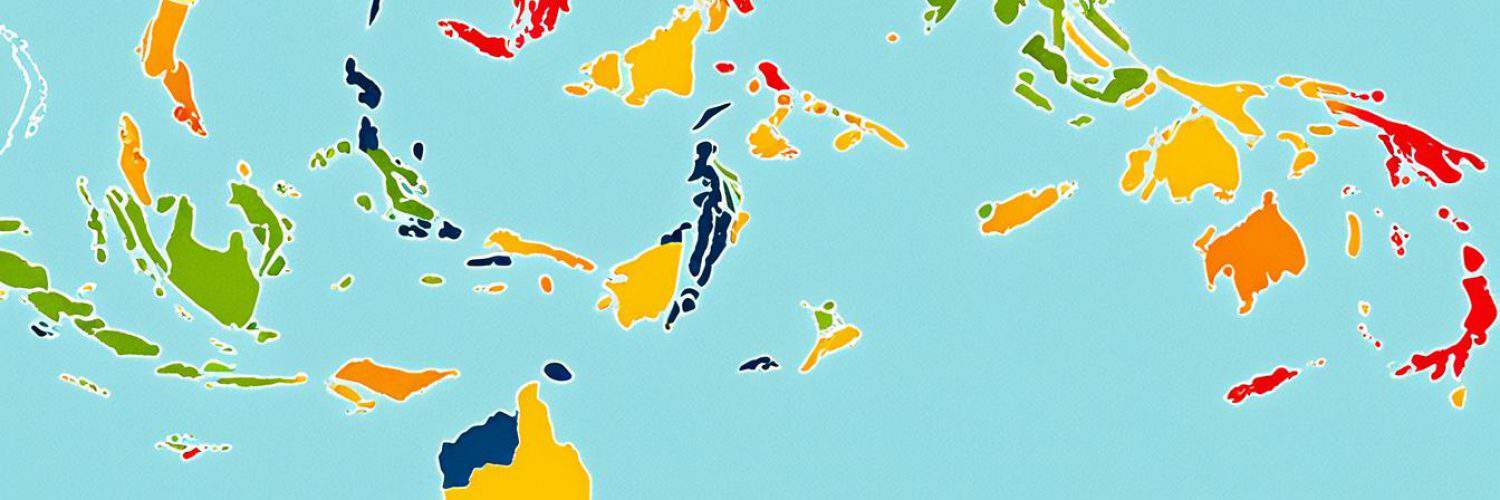Have you ever wondered how many people are living in the Philippines? It’s a fascinating question that can shed light on the country’s population density, demographics, and future challenges. Let’s dive into the statistics and explore the current state of the Philippine population.
Key Takeaways:
- The current population of the Philippines is 118,381,163 as of February 3, 2024.
- The Philippines ranks 13th in the list of countries by population.
- The population density is 394 people per square kilometer.
- The country has a total land area of 298,170 square kilometers.
Population Growth and Trends in the Philippines
The population of the Philippines is experiencing steady growth and significant demographic trends. As of 2023, the estimated population stands at 117,337,368, and it is projected to reach 119,106,224 by 2024.
One noteworthy aspect of the Philippine demographics is the high population growth rate of 1.51%. This indicates a vibrant and expanding population, with new opportunities and challenges arising as a result. The median age in the country is 25.0 years, reflecting a predominantly young population.
The fertility rate in the Philippines is 2.67, indicating the average number of children a woman gives birth to during her lifetime. With a relatively high fertility rate, the country is experiencing continued population growth and an increasing number of young individuals contributing to society.
Furthermore, urban areas are witnessing rapid growth, with 47.1% of the total population residing in cities. This urbanization trend has implications for infrastructure, resources, and quality of life for residents.
These population growth and demographic trends in the Philippines paint a dynamic picture of a country with immense potential for development and progress, while also highlighting the need for effective planning and sustainable policies to address the evolving needs of its people.
Population Forecast for the Philippines
Looking ahead, the population forecast for the Philippines is both significant and promising. By 2050, it is projected that the population will reach a staggering 157,891,622, showcasing a substantial increase compared to the current population. While the growth rate is expected to slow down in the upcoming years, the country still faces the challenge of managing this population surge.
The steady rise in population necessitates careful planning and investment in the future of the young generation. With appropriate strategies and policies in place, the Philippines can capitalize on its demographic potential and pave the way for sustainable development.
| Year | Population |
|---|---|
| 2022 | 112,930,000 |
| 2030 | 134,086,000 |
| 2040 | 150,647,000 |
| 2050 | 157,891,622 |
Source: Population Projections for the Philippines
As the population increases, the government and stakeholders must work collaboratively to ensure that infrastructure, healthcare, education, and employment opportunities can accommodate the swelling numbers. This holistic approach is crucial for maintaining social stability and fostering inclusive growth across the Philippines.
Demographic Challenges in the Philippines
The Philippines is facing significant challenges due to its rapid population growth and urbanization. The country’s population has been growing at an alarming rate, leading to several consequences that need urgent attention.
1. Rapid Population Growth
The Philippines is experiencing rapid population growth, which can put immense pressure on the country’s resources and infrastructure. The increasing population density leads to overcrowding in urban areas, making it challenging to provide essential services and amenities to all residents.
2. Urbanization
Urbanization is another pressing challenge in the Philippines. With the concentration of economic development in urban areas, cities are becoming overcrowded and congested. This rapid urbanization leads to various problems such as inadequate housing, increased pollution, and strained public services.
3. Poverty
Despite economic growth, poverty remains a significant challenge in the Philippines. A considerable portion of the population lacks access to basic resources and struggles to meet their daily needs. This creates a cycle of poverty, hindering social and economic development in the country.
To address these challenges, the Philippine government needs to implement comprehensive strategies and policies that focus on sustainable development and inclusive growth. It is imperative to invest in infrastructure development, promote equitable distribution of resources, and create employment opportunities to uplift the living standards of the population.
“The challenges posed by rapid population growth, urbanization, and poverty in the Philippines require immediate attention and strategic interventions to ensure a better future for all Filipinos.”
By addressing these challenges, the Philippines can foster sustainable development, improve the quality of life for its citizens, and reduce poverty levels, paving the way for a brighter and more prosperous future.
The Youth Bulge and the Demographic Dividend
The Philippines is currently experiencing what is known as a “youth bulge,” with 52% of the population below 24 years old. This demographic phenomenon presents a unique opportunity for the country to tap into what is called the “demographic dividend.”
The demographic dividend refers to the potential economic boost that can be achieved when a country has a large working-age population relative to the dependent population. In the case of the Philippines, the significant proportion of young people represents a potential workforce that can contribute to economic growth and development.
To fully harness this demographic dividend, it is crucial for the government and stakeholders to invest in the education, health, and employment opportunities for the Filipino youth population. By doing so, the country can ensure that young people are equipped with the necessary skills and resources to participate actively in the labor market and contribute to the economy.
“Investing in youth is investing in the future of our country. By empowering young people with education, training, and employment opportunities, we can unlock the full potential of the Filipino youth population and pave the way for sustainable economic growth.”
Furthermore, prioritizing youth development and well-being is not only important for economic reasons but also for promoting social cohesion and inclusive development. By addressing the specific needs and challenges faced by young Filipinos, such as access to quality education, healthcare, and decent work, the country can foster a more equitable and prosperous society.
Overall, the youth bulge in the Philippines presents a significant opportunity for the country to harness the demographic dividend and promote inclusive growth. However, it requires targeted investments, policies, and partnerships to ensure that the Filipino youth population can effectively contribute to the country’s development and prosperity.
Let’s take a closer look at the demographic dividend and the initiatives implemented by the government to capitalize on this opportunity in the following sections.
The Benefits of the Demographic Dividend
The demographic dividend can have several positive effects on a country’s economy and society. Some of the potential benefits include:
- Increased labor force participation and productivity
- Higher savings and investments
- Greater consumer spending
- Improved human capital development
- Promotion of technological innovation
By maximizing the potentials of the demographic dividend, the Philippines can experience sustained economic growth, reduction in poverty rates, and improved social well-being for its population.
Government Initiatives for Harnessing the Demographic Dividend
The Philippine government recognizes the importance of the country’s young population and has launched the National Action Plan on the Demographic Dividend to address their needs. This comprehensive plan focuses on key areas such as healthcare, education, and employment opportunities, aiming to empower the youth and maximize their potential.
The National Action Plan on the Demographic Dividend aligns with the Philippine Development Plan and the Sustainable Development Goals, ensuring a holistic approach to youth development in the Philippines. By implementing this plan, the government aims to create an enabling environment that fosters the growth and well-being of young Filipinos.

In line with the National Action Plan on the Demographic Dividend, the government is committed to:
- Improving access to quality healthcare services, including reproductive healthcare and maternal and child health programs, to promote the overall well-being of young Filipinos.
- Enhancing the education system by investing in infrastructure, curriculum development, and teacher training to provide quality education to all young Filipinos.
- Equipping the youth with the necessary skills and knowledge for employment through vocational training and entrepreneurship programs, ensuring they have opportunities for sustainable livelihoods.
“Investing in the youth today will result in a prosperous nation tomorrow.” – President Rodrigo Duterte
By prioritizing the development of young people, the government recognizes the potential for the demographic dividend to drive economic growth and sustainable development in the Philippines. Through collaborative efforts with various stakeholders, the government aims to create an environment that nurtures the talents and aspirations of the youth, enabling them to become active contributors to society.
| Government Initiatives for Harnessing the Demographic Dividend | Key Focus Areas |
|---|---|
| The National Action Plan on the Demographic Dividend | Healthcare, Education, Employment |
| Investing in quality healthcare services | Reproductive healthcare, Maternal and child health |
| Enhancing the education system | Infrastructure, Curriculum development, Teacher training |
| Equipping the youth for employment | Vocational training, Entrepreneurship programs |
Longitudinal Cohort Study in the Philippines
The Longitudinal Cohort Study in the Philippines is a groundbreaking nationwide research project aimed at understanding the youth demographic and its implications for future policy-making in the country. This study follows 5,000 Filipino girls and boys from the age of 10 to 24, providing valuable insights into their development, challenges, and aspirations.
The Longitudinal Cohort Study in the Philippines plays a crucial role in informing evidence-based decision-making for the Philippine Development Plan and the Sustainable Development Goals. By examining the trajectories of these young individuals over time, researchers can gain a comprehensive understanding of the factors that shape their lives and how best to support their needs.
Key Findings and Implications
Through this study, we have discovered interesting trends and patterns that have important implications for future policy-making in the Philippines:
- This study reveals that education is a key determinant of future outcomes for Filipino youth. Those who complete higher levels of education tend to enjoy better employment prospects and higher incomes. This emphasizes the need for policies that promote access to quality education and ensure that every young Filipino has the opportunity to fulfill their potential.
- Healthcare and social services play a crucial role in youth development. Accessible and affordable healthcare services, as well as comprehensive social support systems, are vital for the well-being and development of young people. Policy interventions should focus on strengthening the healthcare system and improving access to essential services.
- Investing in skills training and job creation is essential for youth empowerment. The study highlights the importance of equipping young Filipinos with the skills they need to participate in the modern workforce. Policies that prioritize vocational training, entrepreneurship support, and job creation initiatives can empower the youth to contribute meaningfully to the nation’s economy.
“The Longitudinal Cohort Study in the Philippines provides a unique opportunity to gain valuable insights into the lives of Filipino youth. Its findings can inform evidence-based policy-making aimed at empowering the youth, reducing inequalities, and achieving sustainable and inclusive development in the country.” – Dr. Maria Santos, Lead Researcher
By leveraging the data and insights from the Longitudinal Cohort Study in the Philippines, policymakers can formulate targeted strategies and interventions that address the specific needs and challenges faced by the youth demographic. This knowledge is critical for shaping policies that promote social equity, economic growth, and overall well-being.
Urbanization and Its Impact in the Philippines
The Philippines is undergoing rapid urbanization, making it one of the fastest urbanizing countries globally. Currently, over 47% of the population resides in urban areas, presenting both opportunities and challenges for the nation.
One of the significant challenges brought about by urbanization is overcrowding. As more people migrate to cities in search of better opportunities, urban areas become densely populated, putting pressure on resources and infrastructure. The strain on housing, transportation, and healthcare systems becomes evident, necessitating careful planning and management to ensure sustainable growth.
Rural poverty is another contributing factor to the trend of urban migration. Economic opportunities and access to basic services such as education and healthcare are often limited in rural areas, prompting individuals and families to seek a better livelihood in urban centers. Addressing rural poverty is crucial in curbing the influx of migrants to cities and promoting equitable development across the country.
“Urbanization is both a blessing and a challenge for the Philippines. It offers the potential for economic growth and improved living standards, but it also necessitates careful management to ensure inclusive development and mitigate the negative impacts.”
To address the challenges posed by urbanization, the Philippine government needs to focus on urban planning and infrastructure development. Smart urban planning that takes into account factors such as population density, transportation networks, and provision of basic services can help create livable cities that cater to the needs of residents.
Furthermore, investments in affordable housing, improved public transportation, and sustainable urban development are essential in mitigating the negative effects of urbanization. By implementing comprehensive policies that address the challenges of rapid urbanization, the Philippines can create thriving cities that provide an excellent quality of life for its inhabitants.
The Impact of Urbanization
Urbanization in the Philippines has several impacts on the society and economy:
- Increased demand for housing: The growing population in urban areas leads to a higher demand for housing, resulting in rising property prices and challenges in providing affordable housing options.
- Strain on infrastructure: Urbanization puts pressure on existing infrastructure such as transportation networks, water supply, and waste management systems. Upgrading and expanding infrastructure is crucial to meet the needs of a growing urban population.
- Economic growth and job creation: Urban areas are often hubs of economic activity, attracting businesses and creating job opportunities. However, ensuring that the benefits of economic growth are inclusive and reach all segments of society is essential.

International Migration and Remittances in the Philippines
Filipino Overseas Workers: Driving Economic Growth
The Philippines is renowned as a major exporter of labor, with an estimated 8 million Filipino overseas workers dispersed across 182 countries. These hardworking individuals venture far from home in pursuit of better opportunities, contributing significantly to the country’s economy and development.
These Filipino overseas workers, often hailed as modern-day heroes, exhibit immense dedication and resilience. They leave their families behind to work in diverse fields such as healthcare, engineering, domestic services, and maritime occupations, making invaluable contributions to their respective host nations.
“Being away from my loved ones is never easy, but the sacrifices I make are worth it. My remittances not only support my family’s needs, but they also help build a better future for my country.”
These selfless individuals understand the impact their efforts have on their families and the larger Philippine society. While they might be physically distant, their influence is felt through the remittances they send back home.
Remittances: A Lifeline for the Philippines
The remittances received from Filipino overseas workers are a vital source of income for many families in the Philippines. These monetary contributions play a significant role in improving living standards, supporting education, and stimulating economic growth.
In 1999 alone, remittances to the Philippines amounted to an impressive US$6.8 billion, demonstrating the magnitude of this financial lifeline. Over the years, these remittances have continued to strengthen the country’s economy, contributing to stability and resilience even during challenging times.
The Impact of Remittances: A Table
| Year | Remittances (in US$ billions) |
|---|---|
| 1999 | 6.8 |
| 2005 | 12.8 |
| 2010 | 21.3 |
| 2015 | 28.4 |
| 2020 | 33.8 |
The table above showcases the steady increase in remittances to the Philippines over the years, indicating the sustained commitment of Filipino overseas workers in supporting their families and contributing to the nation’s progress.
Recognition and Empowerment
Recognizing the invaluable contributions of Filipino overseas workers and the impact of their remittances, the Philippine government has implemented initiatives to support and empower these modern-day heroes. Programs and policies have been established to provide financial literacy, entrepreneurship training, and investment opportunities to Filipino overseas workers and their families.
These efforts aim to maximize the benefits of remittances, ensuring sustainable economic growth and improved livelihoods in the Philippines.
Image:
Population Statistics of Major Cities in the Philippines
The Philippines is home to several major cities with significant populations. These cities are not only economic and cultural hubs but also important contributors to the overall population of the country. Let’s take a closer look at some of the most populous cities in the Philippines.
| City | Population |
|---|---|
| Quezon City | 2,761,720 |
| Manila | 1,600,000 |
| Caloocan City | 1,583,978 |
| Budta | 1,273,715 |
| Davao | 1,244,458 |
As evident from the population statistics, Quezon City stands out as the most populous city in the Philippines, with a population of 2,761,720 people. Manila follows closely behind with a population of 1,600,000. Other major cities such as Caloocan City, Budta, and Davao also have significant population numbers. The urban population in these cities accounts for a large percentage of the total population of the Philippines.
Urbanization plays a vital role in shaping the demographics of the Philippines. These major cities serve as centers of commerce, trade, and employment opportunities. They attract people from rural areas in search of better opportunities and a higher standard of living. The rapid growth of the urban population poses both challenges and opportunities for the country.

Population Health Indicators in the Philippines
The health indicators of a population reflect the overall well-being and quality of life. In the Philippines, several important health indicators provide insights into the country’s healthcare system and the health of its people.
Life Expectancy
The life expectancy in the Philippines is 72.30 years. While this is relatively lower than some other countries, it is important to note that significant progress has been made in improving life expectancy over the years. The advancement in healthcare and access to medical services have contributed to longer and healthier lives for many Filipinos.
Infant Mortality Rate
The infant mortality rate in the Philippines is 21.2 deaths per 1,000 live births. This indicator measures the number of infants who die before their first birthday. While progress has been made in reducing infant mortality, there is still room for improvement. Government initiatives and investments in healthcare are aimed at further reducing this rate and ensuring the well-being of infants and their families.
Mortality Rate for Children Under Age 5
The mortality rate for children under the age of 5 in the Philippines is 25.2 deaths per 1,000 live births. This indicator reflects the overall health and well-being of young children. Efforts are being made to address the underlying causes of child mortality through improved healthcare services, nutrition programs, and disease prevention initiatives.
Understanding and addressing these population health indicators are crucial for promoting the well-being of Filipinos and ensuring a healthier future for the nation. By investing in healthcare infrastructure, improving access to healthcare services, and implementing effective health policies, the Philippines can continue to make progress in these areas and improve the overall health of its population.
Education and Literacy in the Philippines
Education plays a vital role in the development of individuals and societies. In the Philippines, there have been notable improvements in literacy rates and school enrollment over the years. According to available data, the literacy rate in the country is impressively high, with a 95% literacy rate for females and 96% for males. This indicates a commendable commitment to education and the value placed on acquiring literacy skills.
Enrollment in Secondary Schools
Another positive trend in education indicators is the increase in enrollment rates, particularly in secondary schools. More and more young Filipinos are gaining access to education and pursuing secondary education. Notably, enrollment rates for females have been consistently higher than males, indicating a commitment to gender equality in education.
Challenges in Access to Education
Despite these positive developments, challenges still exist in terms of access to education, particularly in rural areas. Limited resources and infrastructure make it difficult for some communities, especially in remote locations, to provide quality education to their residents. Addressing these challenges remains a priority for the government to ensure equitable access to education for all Filipinos.
Investing in education is vital for the progress of any nation. It is through education that individuals acquire knowledge, skills, and values that empower them to contribute meaningfully to society and lead fulfilling lives. The Philippines must continue to prioritize education and work towards creating an inclusive and accessible education system.
Inclusive Education for a Brighter Future
Efforts should be made to further improve education indicators in the Philippines. This includes investing in infrastructure development, enhancing teacher training and capacity building, and promoting inclusive education for students with special needs. By addressing these challenges and investing in education, the Philippines can ensure that all its citizens have equal opportunities to reach their full potential.
Conclusion
In conclusion, the population of the Philippines is experiencing rapid growth, which presents both challenges and opportunities for the country. It is essential for the government to prioritize investment in the future of the young population by providing better healthcare, education, and employment opportunities. Addressing urbanization issues, such as overcrowding and strained resources, is crucial for sustainable development.
By harnessing the demographic dividend and implementing effective policies, the Philippines can achieve inclusive and sustainable growth. The government’s National Action Plan on the Demographic Dividend is a step in the right direction, aiming to meet the needs of the young population and aligning with the Philippine Development Plan and the Sustainable Development Goals.
In order to navigate the future successfully, it is important for the Philippines to continue the Longitudinal Cohort Study, which provides valuable data for future policy-making. By understanding the demographic trends and challenges, the government can make informed decisions to shape the country’s future and improve the quality of life for all Filipinos.
FAQ
How many people are there in the Philippines?
According to the latest data, the current population of the Philippines is 118,381,163 as of February 3, 2024.
What is the population density in the Philippines?
The population density in the Philippines is 394 people per square kilometer.
What is the projected population of the Philippines in 2024?
The projected population of the Philippines in 2024 is 119,106,224.
What is the population growth rate in the Philippines?
The population growth rate in the Philippines is 1.51%.
What is the median age in the Philippines?
The median age in the Philippines is 25.0 years, indicating a young population.
What percentage of the population in the Philippines is below 24 years old?
52% of the population in the Philippines is below 24 years old.
What is the literacy rate in the Philippines?
The literacy rate in the Philippines is 95% for females and 96% for males.
What are the major challenges faced by the Philippines due to its population growth?
The Philippines faces challenges such as overcrowding in cities, urbanization issues, and poverty levels.
What is the government doing to address the needs of the young population?
The Philippine government has launched the National Action Plan on the Demographic Dividend to provide better healthcare, education, and employment opportunities for young people.
How many overseas Filipino workers are there?
There are an estimated 8 million overseas Filipino workers in 182 countries.
Which is the most populous city in the Philippines?
Quezon City is the most populous city in the Philippines with 2,761,720 people.
What is the life expectancy in the Philippines?
The life expectancy in the Philippines is 72.30 years.
What is the infant mortality rate in the Philippines?
The infant mortality rate in the Philippines is 21.2 per 1,000 live births.
How is the Philippine government addressing education challenges?
The Philippine government has increased enrollment rates in secondary schools, particularly for females, but there are still challenges in terms of access to education, especially in rural areas.


















Add comment